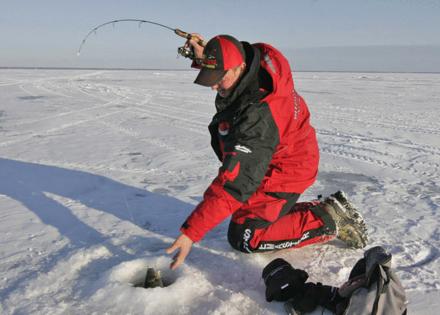Rough Mille Lacs ice season at odds with great fishing. What's going on?
Published in Outdoors
As state officials devise tighter walleye regulations for Lake Mille Lacs, anglers, resort operators, bait shops and other stakeholders have been left to wrestle with two paradoxes.
As described this month by the Department of Natural Resources, the lake's overall walleye population is down 10%, lowering this year's allowable harvest. But despite the population decline, the catch rate on Mille Lacs this winter has soared to its highest level in at least 35 years.
Secondly, despite miserable ice conditions and an epic decline in fishing pressure this winter, anglers reportedly caught a mind-boggling 7,991 pounds of walleyes – more than triple the amount harvested last winter when there was 70% more fishing pressure.
"When you have so few anglers on the ice, how can they catch that many more fish than the masses caught a year ago?'' asked Jason Bahr, owner of Tutt's Bait & Tackle in Garrison. The estimated harvest of nearly 8,000 pounds of walleyes so far this winter is consequential, because it counts against the state's 2024 walleye allocation of 91,550 pounds – an amount certain to require a return to catch-and-release-only fishing for a portion of the upcoming season.
Bahr sits on the DNR's Mille Lacs Fisheries Advisory Committee. He said the DNR isn't lying about the data, but he and others suspect the agency's collection of data is inaccurate.
Bahr said he agrees that walleye fishing on Mille Lacs is phenomenal now. But he believes the high catch rate is caused by walleye abundance, not shrinkage.
"When anglers are catching a lot of fish, it's hard to think the walleye population went down," said Brian Nerbonne, DNR regional fisheries manager in St. Paul.
What follows is the agency's explanation for the counterintuitive conditions:
The DNR shares management of Mille Lacs with the Mille Lacs Band of Ojibwe and several other Native American tribes with treaty rights. Together, they recently estimated an overall 10% decline in the lake's walleye population based on a trio of datasets: Computer modeling, fall netting surveys and a population estimate, once every five years, by an independent expert.
Starting last year, face-to-face surveys of anglers by DNR creel clerks detected a strong walleye bite and rising catch rate. Fisheries managers reasoned that the fish were hungry, not overabundant. The rationale was based on previous parallels between a strong walleye bite on Mille Lacs and a shortage of natural forage for the walleyes to eat.
...continued
©2024 StarTribune. Visit startribune.com. Distributed by Tribune Content Agency, LLC.







Comments